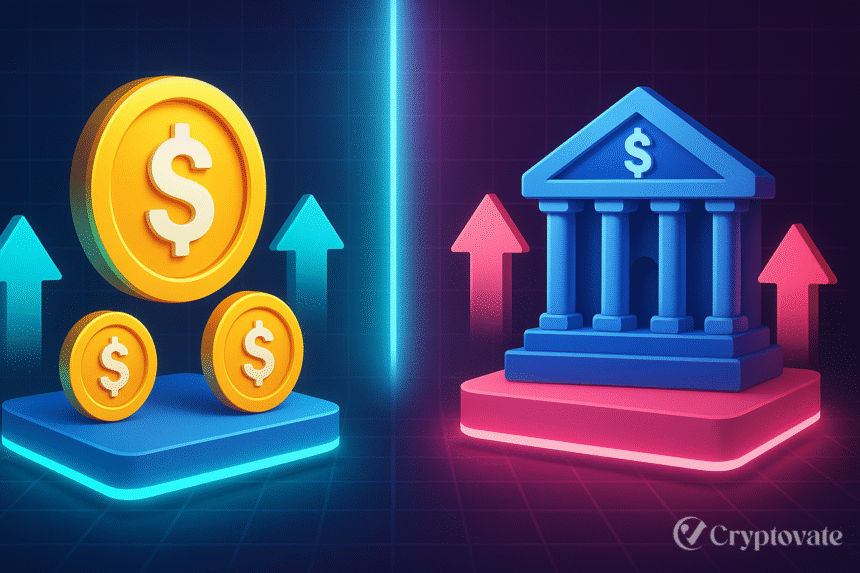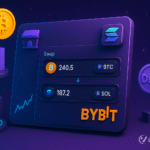– Ad –
| Getting your Trinity Audio player ready... |
Cross-border payments are the backbone of global trade, remittances, and business operations. Yet, traditional banking systems like SWIFT and wire transfers often come with high fees, slow processing times, and limited accessibility. Enter stablecoins—digital currencies pegged to stable assets like the U.S. dollar, transforming how we send money across borders.
This article compares stablecoins to traditional banking, highlighting why blockchain-based payments are gaining traction. Whether you’re a business owner, freelancer, or curious about crypto, you’ll learn how stablecoins are revolutionizing cross-border payments.
What Are Stablecoins?
Stablecoins are cryptocurrencies designed for price stability, typically pegged 1:1 to fiat currencies like USD (e.g., USDC, USDT) or other stable assets like gold. They blend the speed and transparency of digital currencies with the stability of traditional money.
Unlike Bitcoin, which can fluctuate 20-30% in a day, stablecoins maintain consistent value, making them ideal for payments. transactions are recorded on blockchains like Ethereum or Solana, ensuring security and immutability. For a deeper insights into their mechanics, see our guide on Stablecoins for Cross-Border Payments..
Traditional Banking: The Current Standard
Traditional banking relies on systems like SWIFT, a global messaging network connecting over 11,000 financial institutions. While reliable, it has significant drawbacks for cross-border payments:
- High Fees: Average fees range from 6-8%, with some remittances costing up to 12% (World Bank, 2024).
- Slow Settlements: Transfers may take 2-5 business days because of intermediary banks.
- Limited Access: Over 1.4 billion people remain unbanked, unable to access global payment systems (World Bank, 2023).
- Opaque Tracking: Users often lack real-time visibility into transaction status.
These challenges make traditional banking costly and inefficient for many, especially in emerging markets.
Stablecoins: A Game-Changer for Cross-Border Payments
Stablecoins address the pain points of traditional banking, offering a faster, cheaper, and more inclusive alternative. Here’s how they stack up:
1. Lower Transaction Costs
Stablecoin payments typically cost less than 1% per transaction. For example, Solana’s blockchain charges just $0.00025 per transfer, compared to $20-$50 for a SWIFT wire. Businesses sending $10,000 internationally could save over $600 per transaction.
2. Near-Instant Settlements
Unlike bank transfers, which can take days, stablecoin transactions settle in seconds or minutes. USDC on Ethereum, for instance, confirms payments in under 30 seconds, enabling real-time global trade.
3. Global Accessibility
Stablecoins require only a smartphone and internet connection, empowering the unbanked to participate in global markets. Services like Yellow Card leverage USDC to enable payments across over 20 African nations, overcoming traditional banking obstacles.
4. Transparency and Security
Blockchain transactions are immutable and trackable in real time. Every USDT or USDC transfer is recorded publicly, reducing fraud risks and providing full visibility.
To explore how stablecoins power these benefits, check out our in-depth article on Stablecoins for Cross-Border Payments.
Real-World Adoption of Stablecoins
Stablecoins are already transforming industries:
- Remittances: In 2024, stablecoin remittances saved African migrants $1.2 billion in fees (Stellar Foundation).
- E-Commerce: Shopify and PayPal support USDC, simplifying international transactions.
- B2B Payments: Visa’s stablecoin pilot processed $2.5 billion in cross-border transactions in 2024-2025.
- Trade Finance: Circle’s Payments Network enables instant settlements for Asian exporters.
The stablecoin market reached $255 billion in 2025 and is expected to grow to $2 trillion by 2028 (CoinMarketCap), indicating broad adoption.
Challenges of Stablecoins
Despite their advantages, stablecoins face hurdles:
- Regulatory Uncertainty: Countries like India and Nigeria have imposed crypto restrictions, complicating adoption.
- Off-Ramping Issues: Converting stablecoins to local currency can be costly or unavailable in some regions.
- Scalability: High-traffic blockchains like Ethereum can face congestion, though layer-2 solutions like Arbitrum mitigate this.
Traditional banking, while slower, benefits from established regulations and trust, giving it an edge in some scenarios.
Stablecoins vs. Traditional Banking: A Side-by-Side Comparison
| Feature | Stablecoins | Traditional Banking |
| Transaction Fees | <1% (e.g., $0.00025 on Solana) | 6-8% (e.g., $20-$50 per wire) |
| Settlement Time | Seconds to minutes | 2-5 business days |
| Accessibility | Smartphone + internet | Bank account required |
| Transparency | Real-time, public blockchain | Limited tracking, intermediary delays |
| Regulatory Maturity | Evolving (e.g., EU’s MiCA) | Well-established |
The Future of Cross-Border Payments
Stablecoins are poised to dominate global payments as adoption grows. In 2025, initiatives like Circle’s Payments Network and Visa’s stablecoin partnerships are bridging crypto and traditional finance. Regulatory clarity, such as the EU’s MiCA framework, will further boost trust.
Traditional banks are responding by exploring blockchain integration. JPMorgan’s Onyx platform, for example, processes $1 billion daily in blockchain-based payments. However, stablecoins’ speed and cost advantages make them a compelling choice for businesses and individuals.
Conclusion
Stablecoins are revolutionizing cross-border payments by offering lower fees, faster settlements, and greater accessibility than traditional banking. While challenges like regulation persist, their adoption by Visa, PayPal, and millions of users signals a shift toward blockchain-based finance.
Eager to use stablecoins for your business or personal transactions? Dive deeper into their mechanics with our guide on Stablecoins for Cross-Border Payments.
FAQs
Are stablecoins safer than traditional bank transfers?
Stablecoins are secure due to blockchain’s immutability, but risks like wallet hacks or regulatory bans exist. Bank transfers benefit from established protections like FDIC insurance.
Which stablecoins are best for cross-border payments?
USDC and USDT enjoy broad acceptance and offer low transaction fees on networks such as Solana and Polygon. Choose based on your platform’s supported networks.
Can businesses use stablecoins for international trade?
Yes, businesses like Shopify and exporters use USDC for instant, low-cost global payments. Check local regulations before adopting.
How do stablecoins reduce remittance costs?
Stablecoins reduce the need for intermediaries, charging less than 1% in fees versus the 6–8% typical of traditional remittance services, potentially saving migrants billions each year.

















